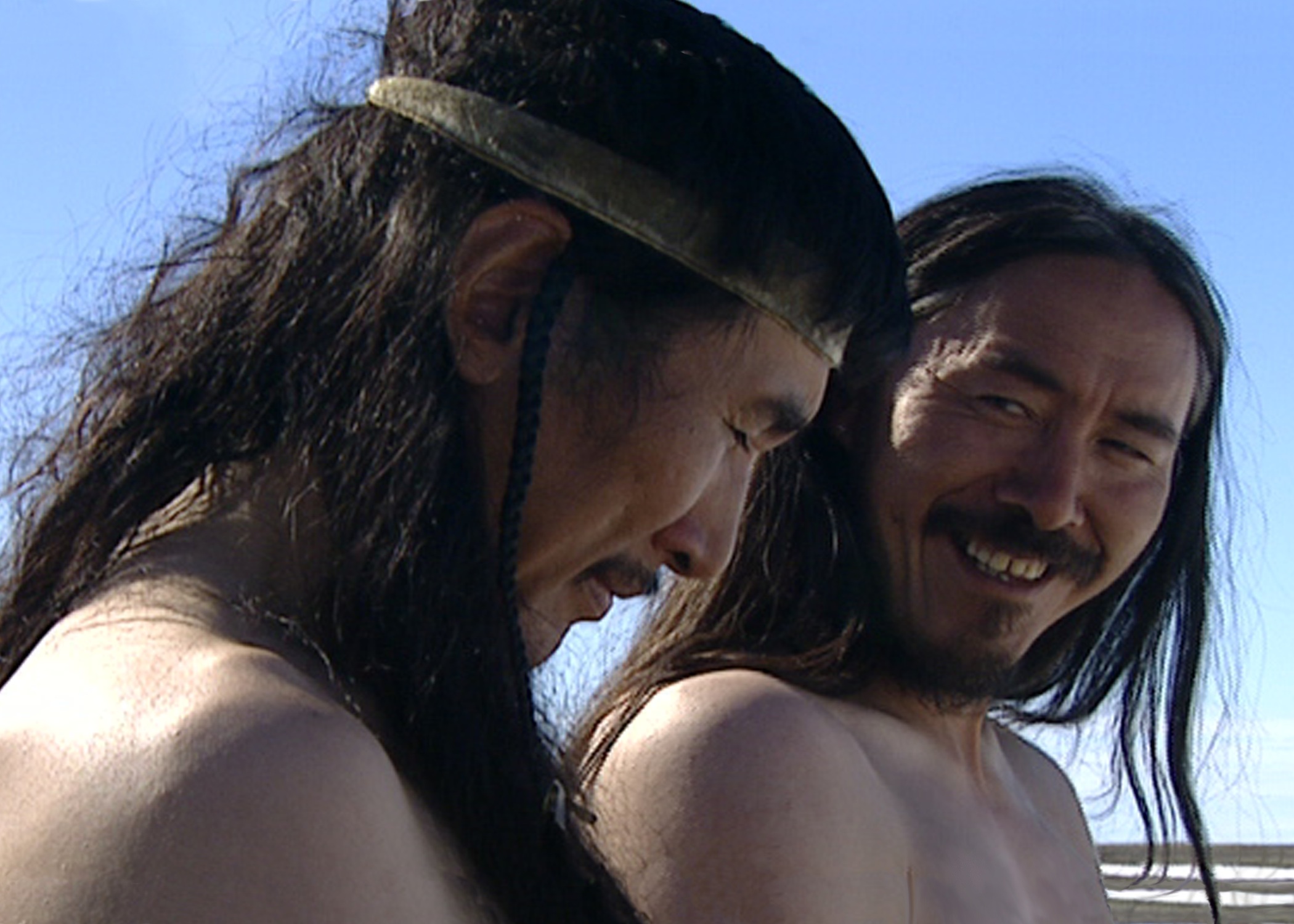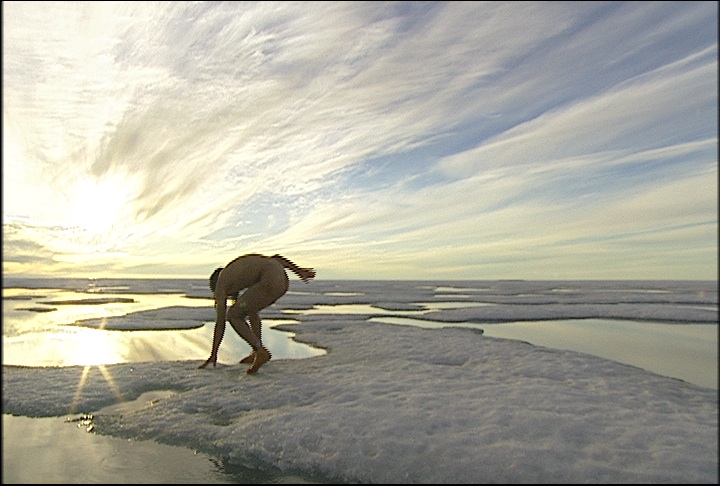
Synopsis
At the dawn of the first millennium, the arrival of a mysterious shaman upsets the natural balance in a community of nomadic Inuit, resulting in the murder of the camp’s leader. Years later, power in the community begins to shift when the tribe’s two best hunters — the brothers Amaqjuaq, the Strong One (Pakak Innuksuk), and Atanarjuat, the Fast Runner (Natar Ungalaaq ) — innocently provoke the new chief’s son, Oki (Peter-Henry Arnatsiaq). After Atanarjuat wins the hand of Oki’s promised wife, the beautiful but flirtatious Atuat (Sylvia Ivalu), in a head punching duel, Oki vows revenge.
When Oki and his friends attempt to kill the brothers in their sleep, Atanarjuat miraculously escapes, running naked for his life across the spring sea ice and eluding Oki with supernatural assistance. He is taken in and nursed back to health by an elderly couple who fled the cursed tribe years earlier. With their guidance and assistance, Atanarjuat regains his spiritual strength, avenges his brother's death and brings harmony back to the tribe.
Background
The first feature film written, produced, directed and acted by Inuit, Atanarjuat (The Fast Runner) was shot on widescreen digital betacam over six months with a budget of $1.9 million. Igloolik Isuma Productions — led by writer-director Zacharias Kunuk and New York-born cinematographer Norman Cohn — had been producing award-winning, community-based media in Nunavut for more than 10 years. They began in 1998 to adapt the ancient folktale of Atanarjuat, recording eight elders telling the story as it had been passed down to them by their ancestors. These accounts were combined into a single detailed treatment in Inuktitut and English, then adapted into the various drafts of the screenplay by Paul Apak Angilirq. He consulted with community elders and Toronto-based story consultant Anne Frank before passing away in December 1998.
All props and costumes were made by Inuit artisans in accordance with traditional methods. Co-produced through the National Film Board’s Aboriginal Filmmaking Program, the film was transferred from betacam to 35mm for its theatrical release. It was the first film of Igloolik Isuma’s Fast Runner Trilogy, which also includes The Journals of Knud Rasmussen (2006) and Before Tomorrow (2008).

Analysis
Despite being shot on digital video, Atanarjuat (The Fast Runner) is epic, even Shakespearean, in scope, culminating in an astounding extended sequence as Atanarjuat races naked across melting ice floes, pursued by the murderous Oki. An authentic recreation of an oral tale told over thousands of years, the film demystifies Indigenous stereotypes by telling a powerful, universal story.
Critical and Audience Reception
From its first screenings at the Cannes Film Festival, the film drew rave reviews. Although some critics found the opening prologue somewhat confusing, the film was still anointed by many as an instant classic. A. O. Scott of the New York Times said the film “is not merely an interesting document from a far-off place; it is a masterpiece… It is, by any standard, an extraordinary film, a work of narrative sweep and visual beauty that honors the history of the art form even as it extends its perspective… Mr. Kunuk has accomplished the remarkable feat of endowing characters from an old folk tale with complicated psychological motives and responses. The combination of dramatic realism and archaic grandeur is irresistibly powerful.”
Roger Ebert called the film “an experience so engrossing it is like being buried in a new environment… The Fast Runner is passion, filtered through ritual and memory.” J. Hoberman of the Village Voice called the film “spectacularly beautiful, not to mention mysterious, sensual, emotionally intense, and… totally absorbing from first image to last.” Maclean’s magazine’s Brian D. Johnson called the film “enthralling… an epic tale of love, jealousy, murder, and revenge worthy of Greek tragedy. Non-professional actors and authentic location open a documentary window on an exotic world — while conjuring surreal, operatic images of horror and beauty... The movie's ritual world is astonishing.”
The second highest-grossing Canadian film of 2002, Atanarjuat was an art-house hit, grossing nearly $4 million in Canada and the US.
As Nunavut marks 20 years as a territory, Leah and Falen shout out mother, grandmother, educator, knowledge keeper and award winning artist Atuat Akittirq.Note: The Secret Life of Canada is hosted and written by Falen Johnson and Leah Simone Bowen and is a CBC original podcast independent of The Canadian Encyclopedia.
Honours and Legacy
Atanarjuat became the first Canadian film to win the coveted Camera d’or at Cannes and went on to receive 19 awards worldwide, as well as five Genie Awards and the Claude Jutra Award (now the Canadian Screen Award for Best First Feature). The film was named one of the top 10 Canadian films of all time in a poll conducted by the Toronto International Film Festival in 2004, and No. 1 overall in 2015.
Awards
2001 Genie Awards
- Achievement in Direction (Zacharias Kunuk)
- Achievement in Editing (Norman Cohn, Zacharias Kunuk, Marie-Christine Sarda)
- Achievement in Music/Original Score (Chris Crilly)
- Best Screenplay (Paul Apak Angilirq)
- Best Motion Picture (Zacharias Kunuk, Norman Cohn, Paul Angilirq, Germaine Ying-Gee Wong)
- Claude Jutra Award (Zacharias Kunuk)
Others
- Camera D’or (Zacharias Kunuk), Cannes Film Festival (2001)
- Guardian Award for Best New Director (tied), Edinburgh International Film Festival (2001)
- Best Canadian Feature Film, Toronto International Film Festival (2001)
- Prix du Public, Festival international de Films de Montréal (2001)
- Grand Prix, Ghent International Film Festival (2001)
- FIPRESCI Prize – Special Mention, Flanders International Film Festival, Ghent (2001)
- Best First Feature, Toronto Film Critics Association Awards (2001)
- Best Film, ImagineNATIVE Media Arts Festival, Toronto (2001)
- Luminaria Award for Best Feature Film, Santa Fe International Film Festival (2001)
- CTV Best of Fest, NextFest Digital Motion Picture Festival (2001)
- Special Mention: Best Feature Film Category, Hawaii International Film Festival (2001)
- Best Foreign-Language Film, Central Ohio Film Critics Association (2001)
- Best Canadian Film, Toronto Film Critics Association Awards (2001)
- Best Feature Film, Banff Mountain Film Festival (2002)
- Lino Brocka Award, Cinemanila International Film Festival (2002)
- Audience Award, Newport International Film Festival (2002)
- Audience Award, Lake Placid Film Forum (2002)
- Festival Award, San Diego International Film Festival (2002)
- Best Foreign Film, Phoenix Film Critics Society Awards (2003)

 Share on Facebook
Share on Facebook Share on X
Share on X Share by Email
Share by Email Share on Google Classroom
Share on Google Classroom